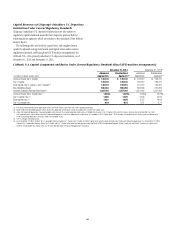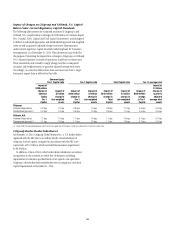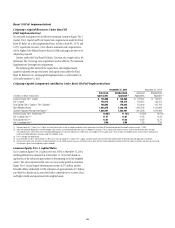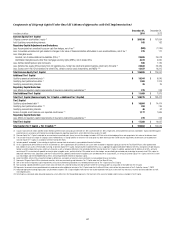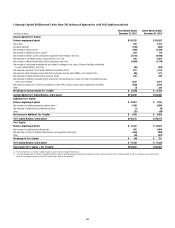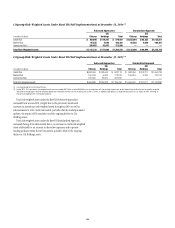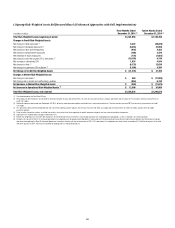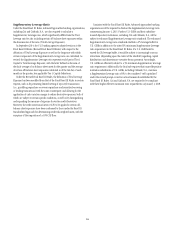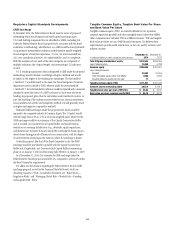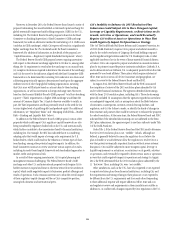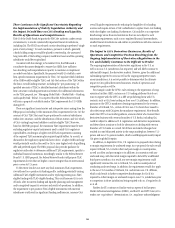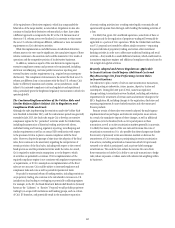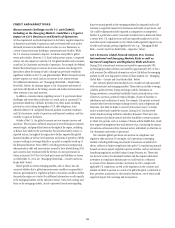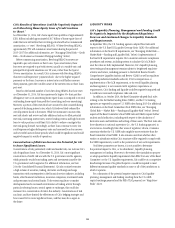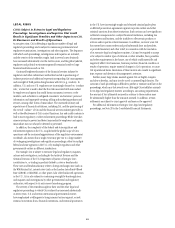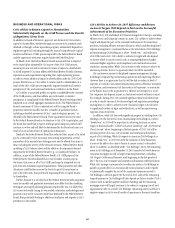Citibank 2014 Annual Report Download - page 71
Download and view the complete annual report
Please find page 71 of the 2014 Citibank annual report below. You can navigate through the pages in the report by either clicking on the pages listed below, or by using the keyword search tool below to find specific information within the annual report.54
RISK FACTORS
The following discussion sets forth what management currently believes
could be the most significant regulatory, credit and market, liquidity,
legal and business and operational risks and uncertainties that could
impact Citi’s businesses, results of operations and financial condition.
Other risks and uncertainties, including those not currently known to Citi
or its management, could also negatively impact Citi’s businesses, results
of operations and financial condition. Thus, the following should not be
considered a complete discussion of all of the risks and uncertainties Citi
may face.
REGULATORY RISKS
Citi Faces Ongoing Significant Regulatory Changes and
Uncertainties in the U.S. and Non-U.S. Jurisdictions in
Which It Operates That Negatively Impact the Management
of Its Businesses and Increase Its Compliance Risks
and Costs.
Citi continues to be subject to a significant number of regulatory changes
and uncertainties across the U.S. and the non-U.S. jurisdictions in which
it operates. Not only has the heightened regulatory environment facing
financial institutions such as Citi resulted in a tendency toward more
regulation, but also in some cases toward the most prescriptive regulation as
regulatory agencies have often taken a restrictive approach to rulemaking,
interpretive guidance, approvals and their general ongoing supervisory or
prudential authority. Moreover, even when U.S. and international regulatory
initiatives overlap, such as with derivatives reforms, in many instances they
have not been undertaken on a coordinated basis, and areas of divergence
have developed with respect to the scope, interpretation, timing, structure or
approach, leading to additional, inconsistent or even conflicting regulations.
Ongoing regulatory changes and uncertainties make Citi’s business
planning difficult and could require Citi to change its business models or
even its organizational structure, all of which could ultimately negatively
impact Citi’s individual businesses, overall strategy and results of operations
as well as realization of its deferred tax assets (DTAs). For example, several
jurisdictions, including in Asia, Latin America and Europe, continue to enact
fee and rate limits on debit and credit card transactions as well as various
limits on sales practices for these and other areas of consumer lending, which
could, among other things, negatively impact GCB’s businesses and revenues.
In addition, during 2014, financial reform legislation was enacted in Mexico
that required an antitrust study of the Mexican financial sector. The study
has been issued and its recommendations include additional regulations
intended to increase competition in the financial services industry in Mexico,
which could negatively impact Citi’s Banamex subsidiary, Mexico’s second
largest bank. In certain jurisdictions, including in the European Union (EU),
there is discussion of adopting a financial transaction tax or similar fees on
large financial institutions such as Citi, which could increase the costs to
engage in certain transactions or otherwise negatively impact Citi’s results
of operations. In addition, various regulators globally continue to consider
adoption of data privacy and/or “onshoring” requirements, such as the EU
data protection framework, that would restrict the storage and use of client
information. These regulations could conflict with anti-money laundering
and other requirements in other jurisdictions, impede information sharing
between Citi’s businesses and increase Citi’s compliance risks and costs.
They could also impede or potentially reverse Citi’s centralization or
standardization efforts, which provide expense efficiencies.
Unless and until there is sufficient regulatory certainty, Citi’s business
planning and/or proposed pricing for affected businesses necessarily include
assumptions based on possible or proposed rules, requirements or outcomes.
Business planning is further complicated by management’s continual need to
review and evaluate the impact on Citi’s businesses of ongoing rule proposals,
final rules, and implementation guidance from numerous regulatory
bodies worldwide, often within compressed timeframes. In some cases,
management’s implementation of a regulatory requirement and assessment
of its impact is occurring simultaneously with changing regulatory guidance,
legal challenges or legislative action to modify or repeal final rules, thus
increasing management uncertainty.
Ongoing regulatory changes also result in higher regulatory and
compliance risks and costs. Citi estimates its regulatory and compliance costs
have grown approximately 10% annually since 2011. These higher regulatory
and compliance costs partially offset Citi’s continued cost reduction
initiatives that are part of its execution priorities and negatively impact its
results of operations. Ongoing regulatory changes and uncertainties also
require management to continually manage Citi’s expenses and potentially
reallocate resources, including potentially away from ongoing business
investment initiatives.
There Continue to Be Changes and Uncertainties Relating
to the Regulatory Capital Requirements Applicable to Citi
and the Ultimate Impact of These Requirements on Citi’s
Businesses, Products and Results of Operations.
Despite the adoption of the final U.S. Basel III rules, there continue to be
changes and uncertainties regarding the regulatory capital requirements
applicable to, and, as a result, the ultimate impact of these requirements
on, Citi.
Citi’s Basel III capital ratios and related components are subject to,
among other things, ongoing regulatory supervision, including review and
approval of Citi’s credit, market and operational risk models, additional
refinements, modifications or enhancements (whether required or otherwise)
to these models and any further implementation guidance in the U.S.
Modifications or requirements resulting from these ongoing reviews, as well
as the ongoing efforts by U.S. banking agencies to finalize and enhance the
regulatory capital framework, have resulted and could continue to result
in changes to Citi’s risk-weighted assets, total leverage exposure or other
components of Citi’s capital ratios. These changes can negatively impact
Citi’s capital ratios and its ability to achieve its capital requirements as it
projects or as required. Further, because operational risk is measured based
not only upon Citi’s historical loss experience but also upon ongoing events
in the banking industry generally, Citi’s level of operational risk-weighted
assets is likely to remain elevated for the foreseeable future, despite Citi’s
continuing efforts to reduce its risk-weighted assets and exposures.


